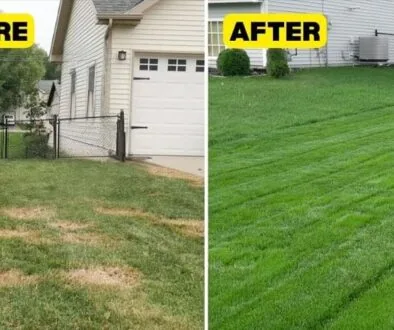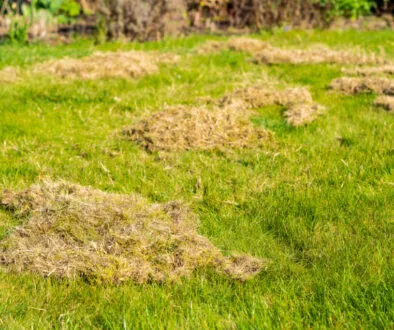Mastering Cool-Season Turfgrass Watering Techniques
Requirements for a Healthy Lawn
Proper watering is one of the most important cultural practices for maintaining healthy cool-season turfgrasses like tall fescue, Kentucky bluegrass, and perennial ryegrass. Whether you’re a property manager, landscaper, or homeowner, understanding the watering requirements and techniques for cool-season turf is key to promoting root growth, preventing disease, and ensuring long-term turf health.
In this blog, we break down when, how much, and how often to water cool-season turf to maintain lush, resilient grass throughout the growing season.
What Are Cool-Season Grasses?
Cool-season grasses thrive in regions with moderate spring and fall temperatures and cool nights. Common types include:
- Tall Fescue – Known for drought tolerance and deep rooting
- Kentucky Bluegrass – Fine-textured, dense, and self-repairing
- Perennial Ryegrass – Quick germination and vibrant green color
These grasses grow most actively during spring (March–May) and fall (September–November) and often go semi-dormant or stressed in the summer heat.
Watering Requirements for Cool-Season Turfgrasses
The general rule for cool-season grasses is to apply 1.0 to 1.5 inches of water per week, including rainfall, during the growing season. During peak summer stress, tall fescue may need closer to 2 inches to avoid dormancy.
Key watering tips:
- Early morning (4–9 AM) is the best time to irrigate.
- Avoid evening watering, which increases disease risk.
- Use a rain gauge or irrigation audit to ensure correct output.
Deep and Infrequent vs. Shallow and Frequent Watering
One of the most common turf mistakes is frequent, shallow watering. This leads to weak root systems and turf that’s highly susceptible to drought and disease.
Instead, focus on deep and infrequent watering, which:
- Encourages roots to grow deeper into the soil
- Improves drought tolerance
- Reduces compaction and fungal issues
Example:
If your system applies 0.5 inches per hour, run it for 30 minutes twice a week to reach the target of 1 inch/week.
How to Tell If Your Turf Needs Water
Signs your cool-season turf is thirsty:
- Grass blades fold or curl lengthwise
- Footprints or mower tracks remain visible
- The turf has a dull bluish-gray cast
To confirm, use a screwdriver or soil probe—if the soil is dry more than 3–4 inches deep, it’s time to water.
Adjusting for Season and Weather
Spring
Watering Frequency: Once or twice per week
Notes: Monitor rainfall; avoid overwatering early in the season
Summer
Watering Frequency: 2–3 times per week (early morning)
Notes: Cool-season grasses may stress or go dormant—don’t overwater to compensate
Fall
Watering Frequency: Once or twice per week
Notes: Critical root development period—maintain moisture without saturation
Winter
Watering Frequency: Rarely needed in most climates
Notes: Avoid watering during freeze events or when turf is fully dormant
Efficient Irrigation Techniques
Consider these tips to reduce waste and maximize turf health:
- Cycle and Soak Method. Break watering into multiple short cycles to avoid runoff on sloped or compacted areas.
- Smart Controllers. Install weather-based or soil moisture sensors to automate irrigation based on real-time needs.
- Zone Auditing. Ensure head-to-head sprinkler coverage and adjust for sun vs. shade exposure.
- Mulch Beds and Edges. Minimize overspray onto hardscape or landscape beds to conserve water.
Special Considerations for Commercial Properties
If you manage business parks, athletic fields, or multi-family properties:
- Group turf areas by sun/shade exposure
- Use ET-based scheduling to align irrigation with real-time evapotranspiration
- Hire a licensed irrigation technician to inspect and adjust the system monthly
- Educate tenants or staff on signs of drought stress to avoid unnecessary service calls
Watering During Drought or Restrictions
During drought conditions or local watering bans:
- Allow cool-season turf to enter natural dormancy
- Minimize foot traffic on dormant turf
- Water once every 3–4 weeks with 0.5 inches to keep crowns alive
Recovery is possible once regular irrigation resumes—especially for tall fescue and bluegrass.
Smart Watering = Healthy Turf
Proper watering is the foundation of cool-season turf health. By adopting deep, infrequent watering, tailoring schedules to weather, and optimizing irrigation systems, you’ll save water, reduce disease, and support vibrant, resilient turf.
Ready to Optimize Your Irrigation System?
Contact Fransen Group today to schedule a professional turf and irrigation audit. Let’s ensure your cool-season turf thrives—efficiently and sustainably.





